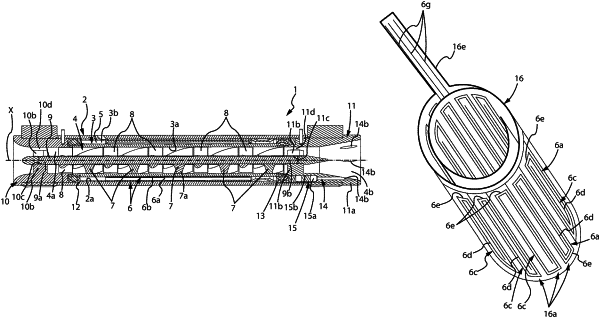| CPC F03B 13/10 (2013.01) [F05B 2220/20 (2013.01); H02K 7/1823 (2013.01)] | 21 Claims |

|
1. A turbine current generator comprising:
a hollow bearing cylinder configured to be engaged inside a pipe or a duct for the transit of a fluid;
a hollow rotating cylinder rotatably and coaxially engaged inside the hollow bearing cylinder and defining a respective transit cylindrical chamber for a fluid, the hollow bearing cylinder and the hollow rotating cylinder defining at least a cylindrical gap;
one or more magnetic or electromagnetic components operatively engaged to the hollow bearing cylinder and/or to the hollow rotating cylinder to generate at least an electric current during the rotation of the hollow rotating cylinder inside the hollow bearing cylinder;
at least one impeller arranged in the transit cylindrical chamber of the hollow rotating cylinder according to a position aligned with a longitudinal axis of the hollow rotating cylinder, the impeller being engaged inside the hollow rotating cylinder so as to rotate integrally with the hollow rotating cylinder upon the action of a fluid which runs through the hollow rotating cylinder and acts on each impeller,
wherein the cylindrical gap is occupied at least partially by a dielectric fluid, the cylindrical gap being hermetically isolated with respect to the transit cylindrical chamber of the hollow rotating cylinder, wherein the cylindrical gap comprises at least one connection channel communicating with the transit cylindrical chamber of the hollow rotating cylinder, at least one pressure compensation device operatively arranged in the connection channel at least to reduce the overall volume of the cylindrical gap as the pressure in the transit cylindrical chamber of the hollow rotating cylinder increases.
|